Argonauta pacifica: Difference between revisions
Mgiganteus1 (talk | contribs) |
Standard headings &/or gen fixes., Replaced: =External link= → =External links= using AWB |
||
| Line 29: | Line 29: | ||
* Sweeney, M. J. (2002). [http://www.tolweb.org/accessory/Argonautidae_Taxa?acc_id=2464 Taxa Associated with the Family Argonautidae Tryon, 1879.] ''Tree of Life web project''. |
* Sweeney, M. J. (2002). [http://www.tolweb.org/accessory/Argonautidae_Taxa?acc_id=2464 Taxa Associated with the Family Argonautidae Tryon, 1879.] ''Tree of Life web project''. |
||
==External |
==External links== |
||
{{CephBase Species|699}} |
{{CephBase Species|699}} |
||
*[http://tolweb.org/tree?group=Argonauta Information on the genus ''Argonauta''] |
*[http://tolweb.org/tree?group=Argonauta Information on the genus ''Argonauta''] |
||
Revision as of 17:38, 14 November 2007
| Pacific Argonaut | |
|---|---|

| |
| Argonauta pacifica eggcase, Baja California. | |
| Scientific classification | |
| Kingdom: | |
| Phylum: | |
| Class: | |
| Order: | |
| Family: | |
| Genus: | |
| Species: | A. pacifica
|
| Binomial name | |
| Argonauta pacifica | |
| Synonyms | |
| |
The Pacific Argonaut (Argonauta pacifica) is a species of pelagic octopus. The female of the species, like all argonauts, creates a paper-thin eggcase that coils around the octopus much like the way a nautilus lives in its shell (hence the name paper nautilus). The shell is usually approximately 150 mm in length, although it can exceed 200 mm in exceptional specimens; the world record size is 220.0 mm.[1]
A. pacifica seems to have a relatively limited distribution, being confined to the waters surrounding western Mexico, and in particular the Gulf of California. For this reason, it is considered one of the rarest of the Argonauta species, along with A. cornuta and A. nouryi.
The taxonomic status of this species questionable. Further research is needed to determine whether it is a valid species or a synonym of another taxon.
The type specimen of A. pacifica was collected off the coast of California and is deposited at the National Museum of Natural History in Washington, D.C..[2]
References
- Sweeney, M. J. (2002). Taxa Associated with the Family Argonautidae Tryon, 1879. Tree of Life web project.
External links
- "CephBase: Argonauta pacifica". Archived from the original on 2005-08-17.
- Information on the genus Argonauta

